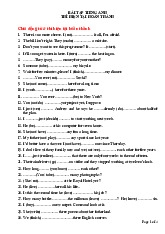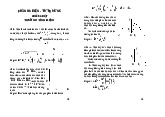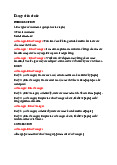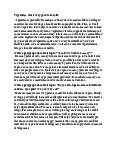



Preview text:
1
1. State your basic understanding on Bankruptcy. What is voluntary
bankruptcy and legal proceedings of bankruptcy?
- Bankruptcy is a legal proceeding initiated when a person or business is
unable to repay outstanding debts or obligations. It offers a fresh start for
people who can no longer afford to pay their bills.
- Voluntary bankruptcy is when a debtor chooses to go to court over
bankruptcy versus being forced to do so. A voluntary bankruptcy is intended
to create an orderly and equitable settlement of the debtor's obligations.
- Legal proceedings of bankruptcy: Bankruptcy involves legal processes
overseen by a court. It aims to fairly distribute available assets among
creditors or, in some cases, restructure debt repayment plans.
2. State your basic understanding on the balance sheet. What are assets and liabilities?
- The balance sheet provides a snapshot of the overall financial condition of
your company at a specific point in time. It lists all of the company’s assets,
liabilities, and owner’s equity in one simple document.
- A balance sheet shows what a company owns (assets), what it owes
(liabilities), and how much owners and shareholders have invested (equity).
- Balance sheet consists of two main categories: assets and liabilities:
+ Assets are the items your company owns that bring in income or provide a future benefit.
+ Liabilities are debts you owe to other parties, including other businesses or the government. 2
3. State your basic understanding on loans, credit lines and leasing.
- Loans involve borrowing a specific amount of money that must be repaid
with interest over a set period, usually in installments.
- A line of credit (LOC) is a preset borrowing limit that can be tapped into at
any time. The borrower can take money out as needed until the limit is
reached. As money is repaid, it can be borrowed again in the case of an open line of credit.
- Leasing involves renting assets (like equipment or property) for a specific
period, with regular payments, without the obligation of ownership at the end of the lease term.
4. State your basic understanding on structure of the bank (bank jobs;
responsibilities and tasks; the hierarchy in a bank)
- Jobs & Responsibilities: Banks have diverse roles, for example:
+ Tellers handling customer transactions
+ Loan officers assessing and approving loans
+ Managers overseeing branch operations
+ CEO leading overall bank strategies
- Hierarchy in a bank: Typically follows a structure from higher management to entry-level positions.
(CEO > Managing Directors > Managers > Employees). 3
5. State your basic understanding of bank products and online banking.
- Bank products refer to the various financial services and instruments that
banks offer to their customers. These include savings and checking accounts,
CDs, loans, credit and debit cards, investment products, retirement accounts,
online banking, and specialized offerings for businesses.
- Online banking, also known as Internet banking, allows customers to
conduct financial transactions conveniently through a bank's website or
mobile app, offering services like electronic payments, balance viewing,
statement access, transaction checking, and fund transfers.
6. State your basic understanding of cash flow in a company? Give
examples of positive and negative cash flow in a company.
- Cash flow is the net cash and cash equivalents transferred in and out of a
company. A company’s cash flow can be positive or negative depending on its cash outflows and inflows.
- Positive cash flow: cash inflow is greater than cash outflow. + Example:
A business starts with $50,000 in cash.
It incurs $63,000 in expenses, but $117,000 of cash inflow enters the business.
>The net cash flow is positive at (50,000 + 117,000) – 63,000 = $104,000
- Negative cash flow: cash inflow is smaller than cash outflow. + Example:
A business starts with $50,000.
Cash inflow is $95,000 but cash outflow is $158,000.
>The net cash flow is negative at (50,000 + 95,000) – (158,000) = -$13,000 4
7. State your basic understanding of corporate banking?
- Corporate banking, also known as business banking, typically serves a
diverse corporation clientele, ranging from small/midsized local businesses
with a few million dollars in revenue to large conglomerates with billions in sales and offices nationwide.
- Corporate banking offers the following products and services:
+ Loans and other credit products
+ Treasury and cash management services + Equipment lending + Commercial real estate + Trade finance + Employer services
8. State your basic understanding of banking regulations?
Bank regulation involves establishing and enforcing rules for financial
institutions to protect consumers, maintain stability in the financial system,
and prevent crimes. It typically comes from both government agencies and central banks.
Bank regulation aims to ensure safe banking practices, fair treatment of
consumers, and access to information.
Common bank regulations include reserve, capital, and liquidity
requirements, along with activity restrictions, to safeguard depositors and maintain system stability.
9. State your basic understanding on liquidity and the business cycle?
- Liquidity: Refers to a company's ability to meet short-term obligations by
converting assets into cash quickly without significant loss in value. The more
liquid an asset is, the easier and more efficient it is to turn it back into cash.
Less liquid assets take more time and may have a higher cost.
- Business Cycle: Describes the recurring fluctuations in economic activity,
including periods of expansion, peak, contraction, and trough. It’s affecting
demand, investment, and employment.




